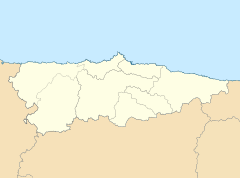Sidrón Cave
| Cueva del Sidrón | |
| Location | Piloña municipality |
|---|---|
| Region | Asturias |
| Coordinates | 43°23′10″N 5°19′42″W / 43.38611°N 5.32833°WCoordinates: 43°23′10″N 5°19′42″W / 43.38611°N 5.32833°W |
| Type | karst |
| History | |
| Periods | Paleolithic |
| Associated with | Neanderthals |
| Site notes | |
| Public access | no |
The Sidrón Cave (Spanish: Cueva del Sidrón) is a non-carboniferous limestone karst cave system located in the Piloña municipality of Asturias, northwestern Spain, where Paleolithic rock art and the fossils of more than a dozen Neanderthals were found. The total length of this huge complex is approximately 3,700 m (12,100 ft), which contains a central hall of 200 m (660 ft) length and the Neanderthal fossil site, called the Ossuary Gallery, which is 28 m (92 ft) long and 12 m (39 ft) wide. Declared a "Partial Natural Reserve" in 1995, the site serves as a retreat for five species of bats and is the place of discovery of two species of Coleoptera (beetles).
The human remains were found accidentally in 1994, all within a single layer (Stratum III). The age of these remains of three men, three adolescent boys, three women, and three infants has been estimated to about 49,000 years. The fact that the bones are excellently preserved with very limited erosion and no large carnivore tooth marks and the unusual deposition of the bones, mixed into a jumble of gravel and mud, suggests that these Neanderthals did not die in this spot but an exterior location. A number of scenarios of how these "members of an extended family" might have ended up in a 6 m2 (65 sq ft) room-sized space, dubbed the Tunnel of Bones included flooding, cave collapse, and disposal by cannibals. Projection exists that they were dropped into the cave in a single event via a collapse of nearby fissures above the site or, by influx of storm water.
The associated assemblage consisted of 53 stone tools, nonhuman bones are very scarce. The only other species present of similar size is Red deer (Cervus elaphus), very few small mammals and gastropods.
Source:
Morphologically, the El Sidrón humans show a large number of Neanderthal lineage-derived features even though certain traits place the sample at the limits of Neanderthal variation. Integrating the El Sidrón human mandibles into the larger Neanderthal sample reveals a north–south geographic patterning. The cave is in the northern portion, southern Neanderthals show broader faces with increased lower facial heights.
...
Wikipedia


